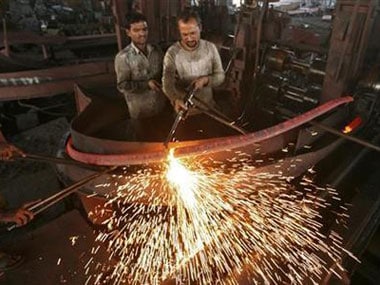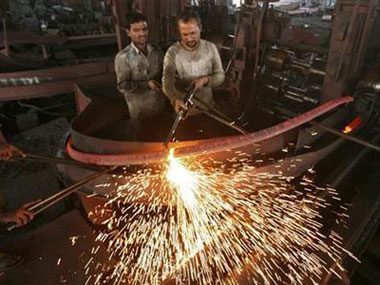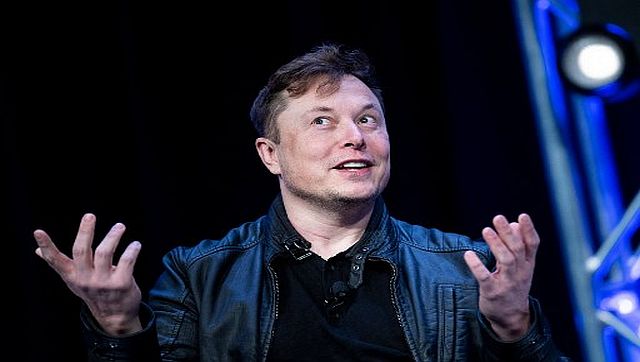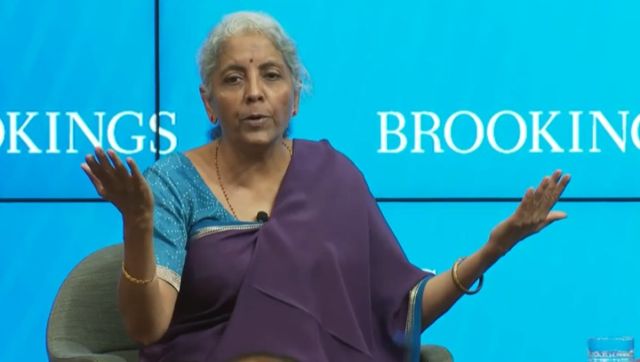India’s GDP grows at 7.2% in third quarter: Key highlights India’s third quarter growth numbers beat all the estimates with the GDP coming in at 7.2 percent which was not according to the polls and opinions given by the experts. Most of the economists had expected GDP will grow in the range of 6.5 to 6.9 percent. The GDP number for October - December quarter at 7.2 percent is much better than what the stock market had expected. FY18 GDP estimate revised upwards to 6.6 percent from earlier 6.5 percent. In third quarter, manufacturing GVA growth was at 8.1 percent as against 6.9 percent in preceding quarter and similar figure was in the corresponding period last year. Agricultural GVA rose by 4.1 percent against 2.7 percent in precedig quarter and 7.5 percent in year ago quarter. Construction showed a 6.8 percent growth compared with 2.8 percent growth in preceding and year-ago quarter. Moody’s Investors Service Wednesday said Indian economy is starting to recover from the negative impact of demonetisation and disruption caused by GST roll out, but kept GDP growth estimates unchanged at 7.6 percent for 2018. In its global growth forecasts for 2018 and 2019, Moody’s said the Budget for fiscal year beginning 1 April (2018-19) includes some measures to stabilise rural economy that was disproportionately hit by scrapping of high denomination 500 and 1000 rupee notes, news agency PTI reported. India might have regained the status of the world’s fastest-growing major economy in the October-December quarter, driven by higher government spending and a pick-up in manufacturing and services. The median in a Reuters poll on annual growth in the December quarter was 6.9 percent, the best pace in 2017. Forecasts ranged from 6.4 percent to 7.3 percent. The government will release GDP data on Wednesday around 1200 GMT. If there was 6.9 percent growth, that would top China’s 6.8 percent annual pace for October-December. The last time India had a faster growth rate was in the final three months of 2016. India’s expected improvement on its 6.3 percent growth in July-September comes as its manufacturing and services sector have been overcoming teething troubles rooted in the bumpy launch of a national sales tax in July. “After muted activity until September, signs of a pick-up in economic growth are starting to appear,” said Aditi Nayar, principal economist at ICRA, the India arm of rating agency Moody‘s. A strong gross domestic product reading could lift domestic shares, and boost the rupee, which has been Asia’s second weakest currency this year, losing about 1.6 percent against the dollar. The GDP data could help Prime Minister Narendra Modi, who faces criticism over mounting bad loans of state banks and a $1.77 billion fraud at state lender Punjab National Bank PNB (PNB), the biggest in the country’s banking history. Last week, Modi told industrialists that his government, which got a “twin balance sheet” problem resulting from bad debt in banks and many businesses, was determined to put the economy back on a higher growth trajectory. [caption id=“attachment_4280443” align=“alignleft” width=“380”]  Representational image. Reuters.[/caption] Modi is trying to accelerate growth through higher state spending including 2.1 trillion rupees ($32.36 billion) for recapitalisation of state banks, beset with mounting bad loans of nearly $148 billion. He has stepped up spending on infrastructure and welfare projects to boost growth ahead of national elections in 2019. This has widened the fiscal deficit for the current fiscal year, ending in March, to 3.5 percent of GDP, instead of the earlier projected 3.2 percent. In November, Moody’s raised India’s investment grade rating one notch, the rating agency’s first upgrade in nearly 14 years. Nascent recovery India jumped 30 places to break into the top 100 for the first time in World Bank’s Doing Business report 2018. The International Monetary Fund forecasts India’s economic growth could reach 7.4 percent in 2018 and 7.8 percent in 2019, overtaking rates projected for China of 6.5 percent and 6.4 percent, respectively. The world’s seventh largest economy, which grew at more than 9 percent a year from 2005 through 2008, is still far from firing on all cylinders. Domestic demand and private investment remain weak. Urjit Patel, governor of the Reserve Bank of India (RBI), earlier this month said the economic recovery was at a nascent stage and called for a cautious approach. The central bank has kept its key rate unchanged since a 25 basis points cut in August. India’s investment rate fell close to 30 percent of GDP in 2017 from a peak of 40 percent in 2011. New Delhi is worried that higher global crude oil prices pose a major risk to its efforts to regain growth momentum as this could hit domestic investment and push up consumer price inflation. (With inputs form agenices)
GDP data key highlights: India's economy grows at 7.2% in third quarter; a booster shot for Narendra Modi govt
A strong GDP reading could lift domestic shares, and boost the rupee, which has been Asia’s second weakest currency this year, losing about 1.6 percent against the dollar.
)
India’s GDP grows at 7.2% in third quarter: Key highlights
The Indian economy grew at five quarter high of 7.2 percent in the October-December period reflecting overall recovery due to good show by agriculture, manufacturing, construction and certain services.
The economy is expected to grow at 6.6 per cent in the current fiscal ending 31 March, as per the second advanced estimates of the Central Statistics Office (CSO), compared to 7.1 percent in 2016-17.
India’s third quarter growth numbers beat all estimates with the GDP comin in at 7.2 percent which was not according to the polls and opinions given by the experts. Most of the economists had expected GDP will grow in the range of 6.5 to 6.9 percent.
The GDP number for October – December quarter at 7.2 percent is much better than what the stock market had expected. FY18 GDP estimate revised upwards to 6.6 percent from earlier 6.5 percent.
In third quarter, manufacturing GVA growth was at 8.1 percent as against 6.9 percent in preceding quarter and similar figure was in the corresponding period last year.
Agricutural GVA rose by 4.1 percent against 2.7 percent in precedig quarter and 7.5 percent in year ago quarter.
Construction showed a 6.8 percent growth compared with 2.8 percent growth in preceding and year-ago quarter.
Fiscal deficit overshoots full-year revised estimate in January
India’s fiscal deficit touched Rs 6.77 lakh crore at the end of January, 113.7 percent of the target for the entire fiscal, on account of higher expenditure.
The fiscal deficit, reflection of government borrowings to meet revenue-expenditure gap, was 113.7 percent in the 10-month period of 2017-18 as compared to 105.7 percent in the year-ago period.
Fiscal deficit had been pegged at Rs 5.33 lakh crore, or 3.5 per cent of the GDP, for the current fiscal ending 31 March. The figure was revised to Rs 5.95 lakh crore in the Union Budget 2018-19, presented in Parliament earlier on 1 February.
As per data released by the Controller General of Accounts (CGA), the revenue deficit during the April-January period of 2017-18, at Rs 4.80 lakh crore works out to 109.2 pr cent of the revised budget estimate.
PTI
‘GDP growth: Some questions on annual numbers, though Q3 looks okay’
The CSO GDP numbers have tended to be fairly whimsical with revisions being common in the past which make drawing conclusions a bit difficult especially when there are still three months data missing. Therefore, when one looks at the growth projected in the second advance estimate for the year which is 6.6 percent, it is at variance at the sector level with higher growth being projected for sectors like manufacturing, public administration, construction and agriculture relative to the first estimate.
This really raises the question as to whether the CSO should be bringing out the first advance estimate in January which is anyway based on extrapolation of information available for the first 2 quarters for the entire year. This may be unnecessary. The overall growth for the year looks reasonable at 6.6 percent, though the GVA growth is to be 6.4 percent, which is a difference of 0.2 percent caused by the net indirect taxes.
This is at variance with the 0.5 percent difference for the Q3 growth numbers which again raises some doubts. The introduction of GST and the changes in accounting has caused significant disturbance in the numbers which are hard to explain. It may be assumed that in the next few quarters they would even out.
Madan Sabnavis, Chief Economist, CARE Ratings
‘GDP at 7.2% driven by growth in agriculture, manufacturing and construction sectors’
“Excellent GDP numbers for Q3FY18 at 7.2 percent driven by growth in agriculture, manufacturing and construction sectors. Though this number comes on back of the low base of Q3FY17 (demonetization quarter), it signifies that the economy is recovering and expanding at a reasonable speed before picking up the pace in near future. It must be noted that Q2FY18 GDP numbers have been revised upwards to 6.5% (from 6.3% earlier). The second advanced estimates for full year FY18 GDP is estimated at 6.6%; given the GDP growth in 9MFY18, the full year GDP growth number is likely to surprise positively. 15% growth in gross fixed capital formations (GFCF) in nominal term is indicative of increased investments happening especially from government side which eventually will lead to higher private spends over next 12-18 months”.
Arun Thukral, MD & CEO, Axis Securities
‘India’s growth outpaced its regional peers, including China, in the last quarter of 2017’
India’s growth outpaced its regional peers, including China, in the last quarter of 2017. Positive set of real GDP growth numbers for Q3 FY18 – strongest in more than a year, boosted also by an upward revision in Q2. Base effects have also been favourable in Q3-Q4, depressed last year by the currency ban.
Improvement was broad-based, with a pick up in most production/investment demand indicators. Under GVA, agri and non-agri activities have both picked pace. Besides base effects, Better construction and agri sectoral performance bodes well for employment creation prospects. Looking ahead, the likelihood of higher rural incomes (on higher MSPs) and pre-election spending is likely to be supportive of FY19 numbers.
Encouraging growth numbers will help take some pressure of other weaker macro-indicators, particularly a wider CAD, fiscal and inflation outlook.
For the debt markets, however, relief might be short-lived as a strong growth picture lowers the bar for the RBI to shift from a neutral to a hawkish gear, should inflation prove sticky beyond June.
Radhika Rao, India Economist, DBS Bank
India’s growth engines begin to fire? asks Dinesh Unnikrishnan, Financial Editor, Firstpost
What is interesting to see in the GVA break-up. Most growth engines are showing some promise compared with the dismal performance in the recent quarters. For instance, manufacturing segment grew at 8.1 percent as against 6.9 percent in the preceding quarter, which is critical from the point of view of job generation.
Similarly, agricultural GVA rose by 4.1 percent against 2.7 percent in the preceding quarter but against 7.5 percent in year-ago quarter. Construction showed a 6.8 percent growth compared with 2.8 percent growth in preceding and year-ago quarter.
GFCF too shows the investment activity growing at a healthy pace with GFCF growing at 12percent in Q3 compared with 6.9 percent in Q2. Government expenditure rose to 6.1 percent from 2.9 percent while private consumption declined marginally to 5.6 percent from 6.6 percent. These are good signals for the economy if shows sustainable trends ahead.
Moody’s keep India’s growth forecast unchanged at 7.6%
Moody’s Investors Service has kept unchanged at 7.6 percent the growth outlook for 2018 for the Indian economy, which is recouping from the impact of demonetisation and Goods and Services Tax (GST).
“There are some signs that the Indian economy is starting to recover from the soft growth patch attributed to the negative impact of the demonetisation undertaken in 2016 and disruption related to last year’s rollout of the Goods and Service Tax,” Moody’s said.
IANS
GDP expected to grow at 6.6 percent in the current fiscal ending 31 March, says CSO
The economy is expected to grow at 6.6 percent in the current fiscal ending 31 March as per the second advanced estimates of the Central Statistics Office (CSO), compared to 7.1 percent in 2016-17. The earlier estimate was 6.5 per cent.
The growth for the second quarter (July-September) has been revised upwards to 6.5 per cent, from 6.3 per cent estimated earlier by the CSO. The previous high was recorded at 7.5 per cent in the July-September quarter of 2016-17.
Core sector grows at 6.7% in January; Cement, refinery output zoom
Eight infrastructure sectors grew a faster pace of 6.7 percent in January against 3.4 percent in the year-ago month as petroleum refinery and cement output zoomed while steel power and coal production improved.
The eight core sectors — coal, crude oil, natural gas, refinery products, fertilisers, steel, cement and electricity — had grew by 4.2 per cent in December and 7.4 per cent in November this financial year.
Petroleum refinery production spurted 11 percent in January against a flat output in the year-ago month. Cement output jumped 20.7 percent in the month against 13.3 percent contraction in the year-ago period.
PTI
India’s Q3 GDP grows at 7.2%, official data shows
India’s GDP for the third quarter of 2017-18 grew at 7.2 percent, official data showed here on Wednesday. The GDP growth during the second quarter of the fiscal was at 6.5 percent.
“The Real GDP at constant (2011-12) prices in the year 2017-18 is likely to attain a level of Rs 130.04 lakh crore, as against the first revised estimate of GDP for the year 2016-17 of Rs 121.96 lakh crore, released on January 31, 2018. The growth in GDP during 2017-18 is estimated at 6.6 percent as compared to the growth rate of 7.1 percent in 2016-17,” the statement said.
IANS
A 7.2% booster growth shot for Narendra Modi government, says Dinesh Unnikrishnan, Financial Editor, Firstpost
As expected, the Q3 GDP growth has come much higher than expected at 7.2 percent beating most estimates. This is a big boost for the Narendra Modi-government. In the Modi-era, GDP numbers have enthused not just economists and academics. It has assumed tremendous political significance too. Economy has been central to Modi-government’s priority list ever since it took over office in May, 2014. For this reason, the opposition has taken on the Modi-government for the steep decline in the GDP numbers till first quarter. Beginning second quarter, the revival trend was seen. The third quarter figures will offer the much needed political boost for Modi government.
First advance estimate: GDP growth seen at four-year low of 6.5% in 2017-18: CSO
The economic growth is expected to slow to a four-year low of 6.5 per cent in 2017-18, the lowest under the Modi-led government, mainly due to poor performance of agriculture and manufacturing sectors
The Gross Domestic Product (GDP) was 7.1 per cent in 2016-17 and 8 per cent in the preceding year. It was 7.5 per cent in 2014-15
The Narendra Modi-led NDA government had assumed office in May 2014
“The growth in GDP during 2017-18 is estimated at 6.5 per cent as compared to the growth rate of 7.1 per cent in 2016- 17,” said the Central Statistics Office (CSO) while announcing the first advance estimates of National Income 2017-18
The growth of real Gross Value Added (GVA) in 2017-18 is anticipated at 6.1 per cent as against 6.6 per cent in the previous year.
PTI
Moody’s Investors Service revised its global growth forecasts for 2018 and 2019
Moody’s Investors Service revised its global growth forecasts for 2018 and 2019, incorporating stronger than expected economic data and reflecting the likely pick up tied to additional US fiscal stimulus.
It revised real GDP growth forecasts upwards for the US, Japan, Germany, France, UK, South Korea, Russia, Saudi Arabia, South Africa and Turkey for 2018.
The rating agency raised its projections of real GDP growth for the US to 2.7 percent in 2018 and 2.3 percent in 2019, from a prior forecast of 2.3 percent and 2.1 percent, respectively.
PTI
India’s April-January fiscal deficit at 113.7% of full year’s target
India’s fiscal deficit for April-January period of 2017-18 stood at 113.7 per cent of the full year’s target, official data showed here on Wednesday.
The data furnished by the Comptroller General of Accounts (CGA) showed that during April-January, the fiscal deficit stood at Rs 6.77 lakh crore, which is 113.7 per cent of the full year’s target.
The capital expenditure during the period stood at Rs 2.64 lakh crore. The revenue deficit during the period was at 4.8 lakh crore, revealed the data.
IANS
This is what Narendra Modi govt needs to do to make India a $5-trillion economy
For India to become a $5 trillion economy, the government needs to go from being a spender to an even greater enabler of businesses than it currently is. Debates about the appropriate level of government spending abound. The tight balance between spending to boost critical sectors versus managing a fiscal deficit is a tightrope the government must walk.
Numbers such as the $526 billion infrastructure gap suggest that innovation in policy will be essential for India to truly bridge this gap, create jobs and generate growth. Our premise is that while spending by the government is important, it needs to focus much more on how to enable businesses, especially private investment in infrastructure.
IANS
Revival of private investments critical, says Dinesh Unnikrishnan, Financial Editor, Firstpost
Watch out for manufacturing and investment growth trends. These are crucial in the context of job generation and broad based revival of the economy going ahead.In the second quarter GDP data, there were signs of a pick up in the gross fixed capital formation (GFCF).
Continuation of this momentum is crucial particularly with respect to private investments. Till now, the economy has largely drawn support from government spending push. But, this cant sustain the economic rebound for long.
India has potential to achieve more than 7-8% GDP growth, says Arun Jaitley
India’s economy has the potential to achieve a growth rate of more than 7-8 percent in view of policy changes, accompanied by a supportive global environment, Finance Minister Arun Jaitley said on Tuesday.
Addressing the India-Korea Business Summit here, he observed that over the next 10-20 years India will continue to remain one of the fastest growing economies in the world.
“India has demonstrated in the last few years that it has, even in a global environment of adversity, a potential to self correct itself, to continue to take difficult decisions if necessary and maintain a high growth trajectory,” Jaitley said.
PTI
A positive surprise for Narendra Modi likely, says Dinesh Unnikrishnan, Financial Editor, Firstpost
GDP numbers will likely surprise on the upside in the third quarter (October-December), if one goes by the surveys conducted by most economists. If that happens ie if GDP comes closer to the 7 percent mark, it will give a big psychological boost to the Narendra Modi government. The Modi administration can then claim that the economy is safely past the bad phase experienced during the demonetisation and GST roll out phase.
India’s GDP growth in October-December likely 6.9 percent, best in 2017: Reuters poll
India’s economy likely grew at its fastest pace in a year in the October-December quarter as consumers, businesses and the government stepped up spending, a Reuters poll predicted.
This suggests that disruptions from a shock ban on high-value currency notes in November 2016 and the chaotic launch of a goods and services tax (GST) in July are fading.
Gross domestic product grew 6.9 percent in the October-December quarter from a year earlier, according to the poll of more than 35 economists, taken over the past week.
If the data, due at 1200 GMT on Feb. 28, matches the consensus, the quarter will have the best growth rate in 2017.
Reuters
Prime Minister Narendra Modi says India will soon become world’s fifth largest economy by nominal GDP
Prime Minister Narendra Modi on Tuesday lauded the pace with which Indian economy was growing. He added that India was already the third largest economy by purchasing power and very soon it will become world’s fifth largest economy by nominal GDP. “We are also the fastest growing major economy of the world today. We are also a country with the one of the largest Start up eco-systems,” Modi said in a tweet.
Moody’s says Indian economy recovering from demonetisation, GST woes; retains FY18 GDP growth at 7.6%
Moody’s Investors Service Wednesday said Indian economy is starting to recover from the negative impact of demonetisation and disruption caused by GST roll out, but kept GDP growth estimates unchanged at 7.6 percent for 2018.
In its global growth forecasts for 2018 and 2019, Moody’s said the Budget for fiscal year beginning 1 April (2018-19) includes some measures to stabilise rural economy that was disproportionately hit by scrapping of high denomination 500 and 1000 rupee notes.
PTI


)
)
)
)
)
)
)
)
)
)



